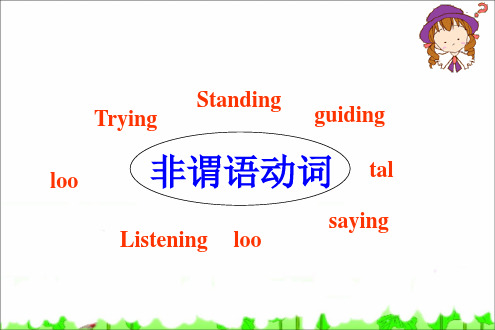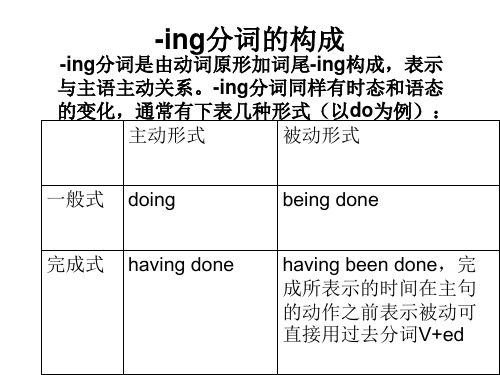高中英语现在分词做状语(共28张PPT)
合集下载
高中英语 语法 现在分词作状语(共31张PPT)

C__o_m__in_g_ _fr_o_m__ Jordan, he moves close to ask you a question.
5. She sat at the desk and did her homework.
She sat at the desk _d_o_in__g_ _h_e_r_ _h_o_m__ew__o_r_k_.
stood up. 由于被要求回答这个问题,他站了起来。
H__a_v_i_n_g_f_in__is_h_e_d_ _h_i_s_h_o_m__e_w_o__r_k_, he stopped
to have a rest. 已经完成了作业,他停下来休息。
N__o_t_h_a_v_i_n_g_ _ta_l_k_e_d__w_i_t_h_J_o_h_n__, she didn’t
• ________ from the rain and snow, • ________ to forget but I won't let go, • ________ at a crowded street, • _________ to my own heart beat, • So many people all around the world, • Tell me where do I find someone like you girl. • Take me to your heart take me to your soul. • Give me your hand before I'm old. • Show me what love is - haven't got a clue. • Show me that wonders can be true. • They say nothing lasts forever, We're only here today • Love is now or never. • Bring me far away. • Take me to your heart take me to your soul. • Give me your hand and hold me, • Show me what love is - be my _________ star, • It's easy take me to your heart. • __________ on a mountain high, • __________ at the moon through a clear blue sky, • I should go and see some friends. • But they don't really comprehend. • Don't need too much _________ without ________ anything. • All I need is someone who makes me wanna sing.
5. She sat at the desk and did her homework.
She sat at the desk _d_o_in__g_ _h_e_r_ _h_o_m__ew__o_r_k_.
stood up. 由于被要求回答这个问题,他站了起来。
H__a_v_i_n_g_f_in__is_h_e_d_ _h_i_s_h_o_m__e_w_o__r_k_, he stopped
to have a rest. 已经完成了作业,他停下来休息。
N__o_t_h_a_v_i_n_g_ _ta_l_k_e_d__w_i_t_h_J_o_h_n__, she didn’t
• ________ from the rain and snow, • ________ to forget but I won't let go, • ________ at a crowded street, • _________ to my own heart beat, • So many people all around the world, • Tell me where do I find someone like you girl. • Take me to your heart take me to your soul. • Give me your hand before I'm old. • Show me what love is - haven't got a clue. • Show me that wonders can be true. • They say nothing lasts forever, We're only here today • Love is now or never. • Bring me far away. • Take me to your heart take me to your soul. • Give me your hand and hold me, • Show me what love is - be my _________ star, • It's easy take me to your heart. • __________ on a mountain high, • __________ at the moon through a clear blue sky, • I should go and see some friends. • But they don't really comprehend. • Don't need too much _________ without ________ anything. • All I need is someone who makes me wanna sing.
分词作状语(共24张PPT)

详细描述
这道练习题将提供一些含有分词作状语的错误句子,要求 学生识别并纠正错误,提高对分词作状语用法的敏感度和 准确性。
总结词
理解分词作状语在复杂句型中的作用
详细描述
这道练习题将通过一些复杂句型,让学生理解分词作状语 在句子中的衔接和修饰作用,以及如何运用分词作状语来 简化复杂句型。
总结词
掌握分词作状语与从句的转换技巧
详细描述
分词短语可以用来描述动作的目的或 意图,例如“为了减肥,我每天早上 跑步。”中的“为了减肥”就是一个 目的状语,表示“我每天早上跑步” 这个动作的目的是减肥。
让步状语
01
让步状语
分词短语表示动作发生的让步条件,通常放在句首或句末 。
02
总结词
表示动作发生的让步条件。
03
详细描述
分词短语可以用来描述动作发生的让步条件,例如“尽管 下雨了,我们还是去了野餐。”中的“尽管下雨了”就是 一个让步状语,表示“我们还是去了野餐”这个动作是在 下雨这个不利条件下发生的。
04
详细描述
这道练习题将重点讲解分词作状语的 时态和语态变化,帮助学生理解不同 时态和语态下分词的使用规则。
06
详细描述
通过这道练习题,学生将进一步提高分词作状 语的运用准确度,避免常见的语法错误,使语 言表达更加规范、准确。
练习题五
总结词
综合运用分词作状语的能力
详细描述
这道练习题将综合考察学生对分词作状语的掌握程度,要求学生在实际语境中灵活运用这一语法点, 提高综合语言运用能力。
总结词
表示动作发生的条件或前提。
详细描述
分词短语可以用来描述动作发生的条件或前提,例如“如果下雨了,我们就不去野餐了。”中的“如果 下雨了”就是一个条件状语,表示“我们就不去野餐了”这个动作发生在下雨这个条件下。
这道练习题将提供一些含有分词作状语的错误句子,要求 学生识别并纠正错误,提高对分词作状语用法的敏感度和 准确性。
总结词
理解分词作状语在复杂句型中的作用
详细描述
这道练习题将通过一些复杂句型,让学生理解分词作状语 在句子中的衔接和修饰作用,以及如何运用分词作状语来 简化复杂句型。
总结词
掌握分词作状语与从句的转换技巧
详细描述
分词短语可以用来描述动作的目的或 意图,例如“为了减肥,我每天早上 跑步。”中的“为了减肥”就是一个 目的状语,表示“我每天早上跑步” 这个动作的目的是减肥。
让步状语
01
让步状语
分词短语表示动作发生的让步条件,通常放在句首或句末 。
02
总结词
表示动作发生的让步条件。
03
详细描述
分词短语可以用来描述动作发生的让步条件,例如“尽管 下雨了,我们还是去了野餐。”中的“尽管下雨了”就是 一个让步状语,表示“我们还是去了野餐”这个动作是在 下雨这个不利条件下发生的。
04
详细描述
这道练习题将重点讲解分词作状语的 时态和语态变化,帮助学生理解不同 时态和语态下分词的使用规则。
06
详细描述
通过这道练习题,学生将进一步提高分词作状 语的运用准确度,避免常见的语法错误,使语 言表达更加规范、准确。
练习题五
总结词
综合运用分词作状语的能力
详细描述
这道练习题将综合考察学生对分词作状语的掌握程度,要求学生在实际语境中灵活运用这一语法点, 提高综合语言运用能力。
总结词
表示动作发生的条件或前提。
详细描述
分词短语可以用来描述动作发生的条件或前提,例如“如果下雨了,我们就不去野餐了。”中的“如果 下雨了”就是一个条件状语,表示“我们就不去野餐了”这个动作发生在下雨这个条件下。
高考英语-分词作状语(共24张PPT)

1.The secretary worked late into the night, _B____a long speech for the president.
A. To prepare B. preparing C. prepared D. was preparing 现在分词作伴随状语
2.European football is played in 80 countries, ___A___ it the most popular sport in the world.
(As I thought he might be at home, I called him.)
3)表方式、伴随情况的状语 :作伴随状语的分 词表示的动作,必须是主语的一个 动作,或是 与谓语所表示的动作(或状态)同时发生,或 是对谓语表示的动词(或状态)作进一步地补 充说明。
Eg. He sat on the sofa, watching TV.
(=He sat on the sofa, and watched TV.)
他们笑着谈着走进了教室。 _L_a_u_g_h_i_n_g_a_n_d__t_a_lk_i_n_g, they went into the classroom. 他斜靠(lean)着墙站着。 He stood leaning against the wall.(=He stood and leaned against the wall.)
extra pay.
working
3. Seen from the top of the hill, we find
the city more beautiful. Seeing
4. Generally speak, facial expressions are
高中英语现在分词做状语(共28张PPT)

beach, I picked up
--
some colorful seashells.
What is the similarities of these sentences?
1.从句主语和主句 现在分词作状语 主语一致
2.句子的主语是分 词动作的发出者
e.g. Seeing those pictures, she
many years, he knew them very well.
doing ?having done?
⑴当分词的动作是由主语发出,而且和 谓语动词同时发生,则用分词的一般形 式.
e.g.
Turning around, she saw an ambulance driving up.
Walking in the street, I caught sight of a tailor shop.
Feeling very tired, they kept running. *现在分词短语作让步状语
*现在分词动作的发出者是( they )
5.The children came into the classroom, and they laughed and talked.
The children came into the classroom, laughing and talking. *现在分词短语作伴随或方式状语
=As he had worked…
2.现在分词何时用完成形式?
当分词的动作是由主语发出,而 且发生在谓语动作之前,则用分 词的完成形式.
Having finished the class, she went home.
=After she finished the class…
--
some colorful seashells.
What is the similarities of these sentences?
1.从句主语和主句 现在分词作状语 主语一致
2.句子的主语是分 词动作的发出者
e.g. Seeing those pictures, she
many years, he knew them very well.
doing ?having done?
⑴当分词的动作是由主语发出,而且和 谓语动词同时发生,则用分词的一般形 式.
e.g.
Turning around, she saw an ambulance driving up.
Walking in the street, I caught sight of a tailor shop.
Feeling very tired, they kept running. *现在分词短语作让步状语
*现在分词动作的发出者是( they )
5.The children came into the classroom, and they laughed and talked.
The children came into the classroom, laughing and talking. *现在分词短语作伴随或方式状语
=As he had worked…
2.现在分词何时用完成形式?
当分词的动作是由主语发出,而 且发生在谓语动作之前,则用分 词的完成形式.
Having finished the class, she went home.
=After she finished the class…
现在分词作定语和状语课件(共18张)

save an old man.
注意:having done或having been done是不 可以作定语的。
现在分词作状语: 现在分词作状语通常可以表示时间、原因、结
果、条件、方式或伴随动作。 例子:
Walking in the park, she saw an old friend. 在公园里散步的时候,她见到了一个老朋友。
和短语的位置是不一样的。
doing 和 being done 作定语的异同。 同: 都表示动作正在进行 异: doing 表示动作和被修饰词是主动关系 being done表示动作和被修饰词是被动关系 The building being built is our library. The fireman rushed into the burning house to
Having finished the work, he went to see his teacher.
完成了工作之后,他去看望了他的老师。 原因状语:
Being ill, he couldn’t go to school. 因为生病了,他无法去上学。
条件状语: Working hard, you’ll make great progress. 如果你努力工作, 你将取得重大进步。 结果状语: His parents died, leaving him an orphan. 他的父母死了,这使得他成了一个孤儿。
核心
现在分词作状语需要注意的问题: 逻辑主语 现在分词作状语,其逻辑主语通常是句子的主
语,它们之间是一种逻辑上的主谓关系。 Hearing the bad news, she didn’t know what
注意:having done或having been done是不 可以作定语的。
现在分词作状语: 现在分词作状语通常可以表示时间、原因、结
果、条件、方式或伴随动作。 例子:
Walking in the park, she saw an old friend. 在公园里散步的时候,她见到了一个老朋友。
和短语的位置是不一样的。
doing 和 being done 作定语的异同。 同: 都表示动作正在进行 异: doing 表示动作和被修饰词是主动关系 being done表示动作和被修饰词是被动关系 The building being built is our library. The fireman rushed into the burning house to
Having finished the work, he went to see his teacher.
完成了工作之后,他去看望了他的老师。 原因状语:
Being ill, he couldn’t go to school. 因为生病了,他无法去上学。
条件状语: Working hard, you’ll make great progress. 如果你努力工作, 你将取得重大进步。 结果状语: His parents died, leaving him an orphan. 他的父母死了,这使得他成了一个孤儿。
核心
现在分词作状语需要注意的问题: 逻辑主语 现在分词作状语,其逻辑主语通常是句子的主
语,它们之间是一种逻辑上的主谓关系。 Hearing the bad news, she didn’t know what
高二现在分词做状语PPT课件

5. Though it was dark, we m__a_d_e__o_u_r_w_a_y_ to the village.
6. As I leave the car, I see that the little boy is _f_a_st__a_sl_e_e_p_.
7. She w__a_s_a_m__a_z_ed__a_t how quickly Carla seemed to get over what had happened to her.
Shower: the place for
thoughts and decision
making.浴室:拿主意做 决定的地方。
用所给短语的适当形式完成句子。 burn to the ground; have a closer look at; make one’s way; fast asleep; feel alive; be about to; protect ... from ...; take notice of; be enthusiastic about; be amazed at
Looking carefully at the ground, I made my way to the edge of the crater.
--- ing 形式作_状__语___
用法
例句
时间 Walking along the street, I met —— Mary. (= While I was walking
◆在语态上,动词-ing表示 __主__动____ (主动/被动的动作)。 在时间上, 动词-ing一般表示 _正__在__进__行__ (正在进行/已经完成)的动作。
The –ing form used as an adverbial:
6. As I leave the car, I see that the little boy is _f_a_st__a_sl_e_e_p_.
7. She w__a_s_a_m__a_z_ed__a_t how quickly Carla seemed to get over what had happened to her.
Shower: the place for
thoughts and decision
making.浴室:拿主意做 决定的地方。
用所给短语的适当形式完成句子。 burn to the ground; have a closer look at; make one’s way; fast asleep; feel alive; be about to; protect ... from ...; take notice of; be enthusiastic about; be amazed at
Looking carefully at the ground, I made my way to the edge of the crater.
--- ing 形式作_状__语___
用法
例句
时间 Walking along the street, I met —— Mary. (= While I was walking
◆在语态上,动词-ing表示 __主__动____ (主动/被动的动作)。 在时间上, 动词-ing一般表示 _正__在__进__行__ (正在进行/已经完成)的动作。
The –ing form used as an adverbial:
初高中衔接教育句子成分--状语课件(共28张)

6.-ed分词短语 (1)过去分词可以作时间、原因、条件、伴随或让步状语,与主语 之间是逻辑上的动宾关系〔即被动关系〕
(2)表示主语所处的状态.〔形容词做状语〕 常见的短语:lost in (迷路,迷失);seated(坐);lost in(沉迷 于……);dressed in(穿着) buried in ;filled with...;intended for...; devoted to...; based on... 等等。 另外由某些动词后面加-ed转化来的形容词也具有此用法,如 frightened, satisfied, tired, disappointed等。 〔1〕 Surprised at what had happened, Tom didn’t know what to do. 原因状语 〔2〕Seen from the hill, the park looks very beautiful. 条件状语 〔3〕Tired with the journey, he soon fell asleep. 原因状语 〔4〕He sat there, lost in thought. 伴随状语
3.介词短语 She will arrive in Beijing on Monday. To everyone’s surprise, Mr. King refused.
4.不定式短语 〔1〕表目的 (可放句首,可放句末) The whole family went to the beach to spend their weekend. 〔2〕表结果 用于too……to, ……enough to do, only to do, sb/sth be +描绘性形容词+to do结构 〔3〕表产生某种情绪的原因 常用于句型“sb be +表情感的形容 词+不定式〞
高中英语-现在分词作状语的几种形式 课件(共23张PPT)

A. angrily pointing B. and point angrily C. angrily point D. and angrily pointing
现在分词作伴随状语
20
4. __C__ a reply, he decided to write again. A. Not receiving B. Receiving not C. Not having
waste your valuable time.
10
比较现在分词和过去分词作状语的区别
1. Following the old man, we went upstairs. (we followed ) (跟着那个老人, 我们上去了)
2. Followed by the old man, we went upstairs. (we were followed) (被那个老人跟着, 我们上去了)
extra pay.
working
3. Seen from the top of the hill, we find
the city more beautiful. Seeing
4. Generally speak, facial expressions are
helpful communications, too. speaking
分词作状语答题记忆口诀
分词作状语,主语是问题。 逗号前后两动作,共用一主语。 主语找出后,再来判关系。 主动-ing,被动用-ed。 Having done 表先后, 千万要牢记。
Having been done 是Having done的被动态
分词的独立主格结构 如果分词和句子没有逻辑上
的主谓关系,则不能用单个的 分词作状语,可以用分词的独 立主格结构或状语从句.
现在分词作伴随状语
20
4. __C__ a reply, he decided to write again. A. Not receiving B. Receiving not C. Not having
waste your valuable time.
10
比较现在分词和过去分词作状语的区别
1. Following the old man, we went upstairs. (we followed ) (跟着那个老人, 我们上去了)
2. Followed by the old man, we went upstairs. (we were followed) (被那个老人跟着, 我们上去了)
extra pay.
working
3. Seen from the top of the hill, we find
the city more beautiful. Seeing
4. Generally speak, facial expressions are
helpful communications, too. speaking
分词作状语答题记忆口诀
分词作状语,主语是问题。 逗号前后两动作,共用一主语。 主语找出后,再来判关系。 主动-ing,被动用-ed。 Having done 表先后, 千万要牢记。
Having been done 是Having done的被动态
分词的独立主格结构 如果分词和句子没有逻辑上
的主谓关系,则不能用单个的 分词作状语,可以用分词的独 立主格结构或状语从句.
高中英语现在分词作状语课件(共26张PPT)

against the ground. (
)
2.动词-ing分词一般式
1. 尽管知道我住在哪里,但他从没来看过我。 _K_n_o_w__in__g__ where I live, he never comes to
see me . Though he knows where I live, he
never comes to see me. 让步状语从句 2. 因为我不知道她的电话号码,所以不能打给 她。 Because I didn’t know her telephone number,
5. _H__a_v_i_n_g__b_e__e_n__t_a_k_e_n___(take) to the lab, we
were taken to the library.
Grammar work: Filling the blanks with –ing form
1. __W__a_lk_i_n_g_s_t_r_a_ig_h_t_____ (一直往前走) , you will
6.从山上看, 我们发现这湖泊更加漂亮了。
If we see from the hill, we find the lake looks more beautiful.
S__e_e_i_n_g_ _f_ro__m_ _t_h_e_h__il_l___, we find that the lake looks more beautiful. -ing分词作条件状语
• Born in Guangzhou, Alice was the only daughter in her family. ‖When she heard the news about Asian Games, she applied to be the first volunteer in her college. ‖ Her parents supported what she had done, and it made her more confident. ‖ Though she was tired , she still did a very good job. ‖ She was considered as the most excellent volunteer, and then Alice was well-known in the college.
现在分词作伴随状语ppt

eg.
伴随
Accompany
1. He died doing what made him happiest.
2. He laughed looking at the funny boy.
3. Tony came into the room, singing and dancing.
Let's do some exercise.
现在分词作状语
The Present Participle as Adverbial
Group 6 Producer: Zhang Xin现添加在题 分词作状语可以表示结果
Rusult
原因
Cause
时间
Time
条件 让步 添加
Condition Concessi标on方题 式
Manner
或
伴随
Accompany
伴随状语首先是一种状语,用来修饰 动词的,
同时是表示与谓语动词同时进行, 即伴随着谓语动词的动作同时进行。
eg.
伴随
Accompany
He said it angrily pointing
at the notice on the wall.
这里,point与said同时进行,因此, pointing在这里是现在分词作伴随 状语,表示主动和正在进行。
books.
6.He lay on the grass, _s_ta_r_i_n_g (stare) at the sky
for a time.
7.He sat there _th_i_n_k_in_g_ (think), with his head on
his hands. 8.The secretary worked late into the night,
现在分词作状语公开课PPT精选文档

24
Assignment
Write a short story with V-ing form used as adverbial.
25
Working hard, you will be successful !
26
A. followed
B. following
C. to be followed D. being followed
现在分词的一般形式:现在分词的动作和
谓语动词的动作几乎同时发生用doing, 被 动式having done
13
_______ such heavy pollution already, it may now be too
late to clean up the river.
A. Having suffered
B. Suffering C. To suffer D. Suffered
现在分词的完成式:当分词
的动作先于谓语动词的动
作发生用分词的完成式: having done,被动是having
been done
________the piano, someone suddenly knocked at the door. A. Playing B. When I was playing C. Repairing D. Examining
A_b__s_o_r_b_e_d_(absorb) in the problem, he didn’t notice the cart moved. Then it moved faster and faster. _S_e_e_i_n_g__(see) that he couldn’t keep up it, he stopped, __s_a_y_i_n_g__(say) to himself, “I’ve never seen a __m__o_v_i_n_g__(move) blackboard.”
Assignment
Write a short story with V-ing form used as adverbial.
25
Working hard, you will be successful !
26
A. followed
B. following
C. to be followed D. being followed
现在分词的一般形式:现在分词的动作和
谓语动词的动作几乎同时发生用doing, 被 动式having done
13
_______ such heavy pollution already, it may now be too
late to clean up the river.
A. Having suffered
B. Suffering C. To suffer D. Suffered
现在分词的完成式:当分词
的动作先于谓语动词的动
作发生用分词的完成式: having done,被动是having
been done
________the piano, someone suddenly knocked at the door. A. Playing B. When I was playing C. Repairing D. Examining
A_b__s_o_r_b_e_d_(absorb) in the problem, he didn’t notice the cart moved. Then it moved faster and faster. _S_e_e_i_n_g__(see) that he couldn’t keep up it, he stopped, __s_a_y_i_n_g__(say) to himself, “I’ve never seen a __m__o_v_i_n_g__(move) blackboard.”
高二英语现在分词作状语(PPT)5-2

成溃疡,症状是鼻涕带脓,鼻腔内有溃斑。也能使人感染。 【鼻孔】名鼻腔跟外面相通的孔道。 【鼻梁】(~儿)名鼻子隆起的部分:高~|塌~儿。也叫
鼻梁子。 【鼻牛儿】〈方〉名鼻腔里干结的鼻涕。 【鼻衄】ǜ动中医指鼻子流血,多由鼻外伤、鼻腔疾患等引起。 【鼻旁窦】名头颅内部鼻腔周围的空腔。 通称鼻窦。 【鼻腔】名鼻子内部的空腔,分左右两个,壁上有细毛。上部黏膜中有嗅觉细胞,能分辨气味。 【鼻青脸肿】ī鼻子青了,脸也肿了,形容面部 被碰伤或打伤的样子。也比喻遭到严重打击或挫折的狼狈相。 【鼻儿】名①器物上面能够穿上其他东西的小孔:门~|
-ing分词的被动式
-ing分词的被动式表示与后面句子的主语是被 动关系。根据-ing分词动作发生的时间,被 动式有一般被动式(being done)和完成被动 式(having been done)。如:
(Having been criticized) by the teacher, he gave up smoking. 被老师批评以后, 他把烟戒了。
-ing分词的构成
-ing分词是由动词原形加词尾-ing构成,表示
与主语主动关系。-ing分词同样有时态和语态
的变化,通常有下表几种形式(以do为例):
主动形式
被动形式
一般式 doing
being done
完成式 having done
having been done,完 成所表示的时间在主句 的动作之前表示被动可 直接用过去分词V+ed
别人结婚。 【逼近】ī动靠近;接近:小艇~了岸边|天色已经~黄昏|脚步声从远处渐渐~。 【逼良为娼】ī逼迫良家妇女当娼妓,也比喻迫使正直安分的 人去做坏事。 【逼命】ī动①指用暴力威胁人。②比喻催促得十分紧急,使人感到紧张,难以应付:真~!这么重的任务,三天内怎能完成! 【逼平】ī动体 育比赛中,处于劣势的一方经过努力,迫使; 华语作文 华语作文 ;对手接受平局。 【逼迫】ī动紧紧地催促;用压力促使:在环境的~下, 他开始变得勤奋了。 【逼抢】ī动紧逼着争抢(多用于足球、篮球等球类比赛):~凶狠。 【逼上梁山】ī《水浒传》中有林冲等人为官府所迫,上梁山造反 的情节。后用来比喻被迫进行反抗或不得不做某种事。 【逼视】ī动向前靠近目标,紧紧盯着:光彩夺目,不可~|在众人的~下,他显得局促不安了。 【逼问】ī动强迫被问者回答:无论怎么~,他就是不说。 【逼肖】ī〈书〉动很相似:虽是绢花,却与真花~。 【逼仄】ī〈书〉形(地方)】ī形①极像真的:情节~|这个老虎画得十分~。②真切:看得~|听得~。 【??】(鎞)ī〈书〉①钗。②篦 子。 【鲾】(鰏)ī名鱼,身体小而侧扁,略呈卵圆形,青褐色,口小,鳞细。生活在近海。种类很多,有牙鲾、鹿斑鲾等。 【荸】[荸荠](?)名①多年 生草本植物,通常栽培在水田里,地下茎扁圆形,皮红褐色或黑褐色,肉白色,可以吃,也可制淀粉。②这种植物的地下茎。‖有的地区叫地栗或马蹄。 【鼻】①名鼻子:~梁|~音。②〈书〉开创:~祖。 【鼻翅儿】名鼻翼的通称。 【鼻窦】名鼻旁窦的通称。 【鼻化元音】ī见页〖元音〗。 【鼻尖】(~ 儿)名鼻子末端最突出的部分。也叫鼻子尖儿。 【鼻疽】名马、驴、骡的一种传染病,由鼻疽杆菌引起,在内脏、鼻腔黏膜和皮下形成小结节,坏死后,变
鼻梁子。 【鼻牛儿】〈方〉名鼻腔里干结的鼻涕。 【鼻衄】ǜ动中医指鼻子流血,多由鼻外伤、鼻腔疾患等引起。 【鼻旁窦】名头颅内部鼻腔周围的空腔。 通称鼻窦。 【鼻腔】名鼻子内部的空腔,分左右两个,壁上有细毛。上部黏膜中有嗅觉细胞,能分辨气味。 【鼻青脸肿】ī鼻子青了,脸也肿了,形容面部 被碰伤或打伤的样子。也比喻遭到严重打击或挫折的狼狈相。 【鼻儿】名①器物上面能够穿上其他东西的小孔:门~|
-ing分词的被动式
-ing分词的被动式表示与后面句子的主语是被 动关系。根据-ing分词动作发生的时间,被 动式有一般被动式(being done)和完成被动 式(having been done)。如:
(Having been criticized) by the teacher, he gave up smoking. 被老师批评以后, 他把烟戒了。
-ing分词的构成
-ing分词是由动词原形加词尾-ing构成,表示
与主语主动关系。-ing分词同样有时态和语态
的变化,通常有下表几种形式(以do为例):
主动形式
被动形式
一般式 doing
being done
完成式 having done
having been done,完 成所表示的时间在主句 的动作之前表示被动可 直接用过去分词V+ed
别人结婚。 【逼近】ī动靠近;接近:小艇~了岸边|天色已经~黄昏|脚步声从远处渐渐~。 【逼良为娼】ī逼迫良家妇女当娼妓,也比喻迫使正直安分的 人去做坏事。 【逼命】ī动①指用暴力威胁人。②比喻催促得十分紧急,使人感到紧张,难以应付:真~!这么重的任务,三天内怎能完成! 【逼平】ī动体 育比赛中,处于劣势的一方经过努力,迫使; 华语作文 华语作文 ;对手接受平局。 【逼迫】ī动紧紧地催促;用压力促使:在环境的~下, 他开始变得勤奋了。 【逼抢】ī动紧逼着争抢(多用于足球、篮球等球类比赛):~凶狠。 【逼上梁山】ī《水浒传》中有林冲等人为官府所迫,上梁山造反 的情节。后用来比喻被迫进行反抗或不得不做某种事。 【逼视】ī动向前靠近目标,紧紧盯着:光彩夺目,不可~|在众人的~下,他显得局促不安了。 【逼问】ī动强迫被问者回答:无论怎么~,他就是不说。 【逼肖】ī〈书〉动很相似:虽是绢花,却与真花~。 【逼仄】ī〈书〉形(地方)】ī形①极像真的:情节~|这个老虎画得十分~。②真切:看得~|听得~。 【??】(鎞)ī〈书〉①钗。②篦 子。 【鲾】(鰏)ī名鱼,身体小而侧扁,略呈卵圆形,青褐色,口小,鳞细。生活在近海。种类很多,有牙鲾、鹿斑鲾等。 【荸】[荸荠](?)名①多年 生草本植物,通常栽培在水田里,地下茎扁圆形,皮红褐色或黑褐色,肉白色,可以吃,也可制淀粉。②这种植物的地下茎。‖有的地区叫地栗或马蹄。 【鼻】①名鼻子:~梁|~音。②〈书〉开创:~祖。 【鼻翅儿】名鼻翼的通称。 【鼻窦】名鼻旁窦的通称。 【鼻化元音】ī见页〖元音〗。 【鼻尖】(~ 儿)名鼻子末端最突出的部分。也叫鼻子尖儿。 【鼻疽】名马、驴、骡的一种传染病,由鼻疽杆菌引起,在内脏、鼻腔黏膜和皮下形成小结节,坏死后,变
- 1、下载文档前请自行甄别文档内容的完整性,平台不提供额外的编辑、内容补充、找答案等附加服务。
- 2、"仅部分预览"的文档,不可在线预览部分如存在完整性等问题,可反馈申请退款(可完整预览的文档不适用该条件!)。
- 3、如文档侵犯您的权益,请联系客服反馈,我们会尽快为您处理(人工客服工作时间:9:00-18:30)。
*现在分词动作的发出者是( the children )
D. Choose the best answer.
1._______ at my classmates’ faces, I read the same excitement in their eyes.
A.Looking B. Look C. To look D. Looked
Staying here for some time, you’ll find the people here are friendly.条件
When leaving the airport ,they waved again and again.时间
While reading the book, he nodded from time to time.时间
Compare the following sentences
Turning around, she saw an ambulance driving up. Walking in the street, I caught sight of a
tailor shop. Having finished the class, she went home. Having worked among the peasants for
Holding the note in his hand, he stood there quietly.方式
The old man died, leaving nothing but debts.结果 Being ill , she didn’t go to school today.原因
2.“Can’t you read?” Mary said ________ to the notice.
A.angrily pointing B. and point angrily C.angrily pointed D. and angrily pointing
3. While building a tunnel through the mountain, _______.
Walking in the beach, I picked up
--
some colorful seashells.
What is the similarities of these sentences?
1.从句主语和主句 现在分词作状语 主语一致
2.句子的主语是分 词动作的发出者
e.g. Seeing those pictures, she
5.The visiting Minister expressed
his satisfaction with the
tacks, that he had enjoyed
his stay here.
A.having added B.to add
C.adding
D.added
Conclusion 现在分词作状语代替状语从句:
a.(从句的主语)和 (主句的主语)必须一致
b.现在分词作状语含有 _主__动__和 _进__行__意义。
Homework Finish the exercise on P37 金榜学案
现在分词的时态和语态
主动形式
一 般
doing
式
完
成 having done
式
被动形式
being done
having been done
seeing his mother,the baby burst into
---- ------
laughter.
Because he was poor
Being poor, h--e-couldn’t afford a TV
set.
When I was walking in the beach
A. an underground lake was discovered B. there was an underground lake
discovered C. a lake was discovered underground D. the workers discovered an
underground lake
set.
When I was walking in the beach
Walking in the beach, I picked up
--
some colorful seashells.
讨论:
什么情况下才能用现在分词 做状语?
A.观察下列句子W,找he出n h分e 词saw动h作is 的mo发th出er者。
=As he had worked…
*现在分词动作的发出者是( you )
2.Because he was ill, he couldn’t go to school.
Being ill, he couldn’t go to school.
*现在分词短语作原因状语
*现在分词动作的发出者是( he ) 3.When they saw their teacher, the
2.现在分词何时用完成形式?
当分词的动作是由主语发出,而 且发生在谓语动作之前,则用分 词的完成形式.
Having finished the class, she went home.
=After she finished the class…
1、When I heard the noise,I turned
注意:现在分词短语作时间状语,所表 示的动作与主句的动作同时发生,有时 可由连词when, while引出。
C.把状语从句改写成分词短语并说明其功能
1.If you work harder at English, you will make greater progress.
Working harder at English, you will make greater progress. *现在分词短语作条件状语
many years, he knew them very well.
doing ?having done?
⑴当分词的动作是由主语发出,而且和 谓语动词同时发生,则用分词的一般形 式.
e.g.
Turning around, she saw an ambulance driving up.
Walking in the street, I caught sight of a tailor shop.
Feeling very tired, they kept running. *现在分词短语作让步状语
*现在分词动作的发出者是( they )
5.The children came into the classroom, and they laughed and talked.
The children came into the classroom, laughing and talking. *现在分词短语作伴随或方式状语
remembered her childhood.
When she saw those pictures, she remembered her childhood.
现在分词作状语相当于状语从句
你知道哪些状语从 句?
时间、原因、结果、条件、 让步、方式或伴随…
B 辨别句子中分词表示的状语从句类型
round.
=_____________
,I turned
round.
2、Because he knows the answer, he
finishes the exercise quickly.
= ___________________,he finishes the
exercise quickly.
A.观察下列句子W,找he出n h分e 词saw动h作is 的mo发th出er者。
seeing his mother,the baby burst into
---- ------
laughter.
Because he was poor
Being poor, h--e-couldn’t afford a TV
练一练
When they left the airport, they waved again and again.
When leaving the airport ,they waved again and again.
.Having worked among the peasants for many years, he knew them very well.
4.When____ different cultures, we often pay attention only to the differences without noticing the many similarities.
A.being compared paring C.having compared pared
students stood up.
Seeing their teacher, the students stood
up. *现在分词短语作( 时间 )状语 *现在分词动作的发出者是(the students)
4.Although they felt very tired,they kept running.
D. Choose the best answer.
1._______ at my classmates’ faces, I read the same excitement in their eyes.
A.Looking B. Look C. To look D. Looked
Staying here for some time, you’ll find the people here are friendly.条件
When leaving the airport ,they waved again and again.时间
While reading the book, he nodded from time to time.时间
Compare the following sentences
Turning around, she saw an ambulance driving up. Walking in the street, I caught sight of a
tailor shop. Having finished the class, she went home. Having worked among the peasants for
Holding the note in his hand, he stood there quietly.方式
The old man died, leaving nothing but debts.结果 Being ill , she didn’t go to school today.原因
2.“Can’t you read?” Mary said ________ to the notice.
A.angrily pointing B. and point angrily C.angrily pointed D. and angrily pointing
3. While building a tunnel through the mountain, _______.
Walking in the beach, I picked up
--
some colorful seashells.
What is the similarities of these sentences?
1.从句主语和主句 现在分词作状语 主语一致
2.句子的主语是分 词动作的发出者
e.g. Seeing those pictures, she
5.The visiting Minister expressed
his satisfaction with the
tacks, that he had enjoyed
his stay here.
A.having added B.to add
C.adding
D.added
Conclusion 现在分词作状语代替状语从句:
a.(从句的主语)和 (主句的主语)必须一致
b.现在分词作状语含有 _主__动__和 _进__行__意义。
Homework Finish the exercise on P37 金榜学案
现在分词的时态和语态
主动形式
一 般
doing
式
完
成 having done
式
被动形式
being done
having been done
seeing his mother,the baby burst into
---- ------
laughter.
Because he was poor
Being poor, h--e-couldn’t afford a TV
set.
When I was walking in the beach
A. an underground lake was discovered B. there was an underground lake
discovered C. a lake was discovered underground D. the workers discovered an
underground lake
set.
When I was walking in the beach
Walking in the beach, I picked up
--
some colorful seashells.
讨论:
什么情况下才能用现在分词 做状语?
A.观察下列句子W,找he出n h分e 词saw动h作is 的mo发th出er者。
=As he had worked…
*现在分词动作的发出者是( you )
2.Because he was ill, he couldn’t go to school.
Being ill, he couldn’t go to school.
*现在分词短语作原因状语
*现在分词动作的发出者是( he ) 3.When they saw their teacher, the
2.现在分词何时用完成形式?
当分词的动作是由主语发出,而 且发生在谓语动作之前,则用分 词的完成形式.
Having finished the class, she went home.
=After she finished the class…
1、When I heard the noise,I turned
注意:现在分词短语作时间状语,所表 示的动作与主句的动作同时发生,有时 可由连词when, while引出。
C.把状语从句改写成分词短语并说明其功能
1.If you work harder at English, you will make greater progress.
Working harder at English, you will make greater progress. *现在分词短语作条件状语
many years, he knew them very well.
doing ?having done?
⑴当分词的动作是由主语发出,而且和 谓语动词同时发生,则用分词的一般形 式.
e.g.
Turning around, she saw an ambulance driving up.
Walking in the street, I caught sight of a tailor shop.
Feeling very tired, they kept running. *现在分词短语作让步状语
*现在分词动作的发出者是( they )
5.The children came into the classroom, and they laughed and talked.
The children came into the classroom, laughing and talking. *现在分词短语作伴随或方式状语
remembered her childhood.
When she saw those pictures, she remembered her childhood.
现在分词作状语相当于状语从句
你知道哪些状语从 句?
时间、原因、结果、条件、 让步、方式或伴随…
B 辨别句子中分词表示的状语从句类型
round.
=_____________
,I turned
round.
2、Because he knows the answer, he
finishes the exercise quickly.
= ___________________,he finishes the
exercise quickly.
A.观察下列句子W,找he出n h分e 词saw动h作is 的mo发th出er者。
seeing his mother,the baby burst into
---- ------
laughter.
Because he was poor
Being poor, h--e-couldn’t afford a TV
练一练
When they left the airport, they waved again and again.
When leaving the airport ,they waved again and again.
.Having worked among the peasants for many years, he knew them very well.
4.When____ different cultures, we often pay attention only to the differences without noticing the many similarities.
A.being compared paring C.having compared pared
students stood up.
Seeing their teacher, the students stood
up. *现在分词短语作( 时间 )状语 *现在分词动作的发出者是(the students)
4.Although they felt very tired,they kept running.
